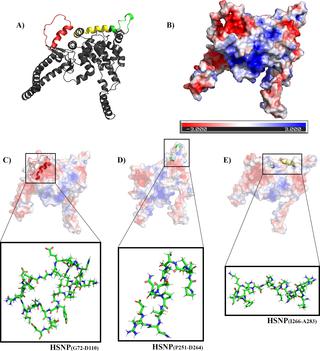当前位置:
X-MOL 学术
›
PLOS Negl. Trop. Dis.
›
论文详情
Our official English website, www.x-mol.net, welcomes your
feedback! (Note: you will need to create a separate account there.)
Identification and validation of specific B-cell epitopes of hantaviruses associated to hemorrhagic fever and renal syndrome.
PLOS Neglected Tropical Diseases ( IF 3.4 ) Pub Date : 2019-12-16 , DOI: 10.1371/journal.pntd.0007915 Fernando de Paiva Conte 1 , Bianca Corrêa Tinoco 1 , Thiago Santos Chaves 1 , Renata Carvalho de Oliveira 2 , Janaina Figueira Mansur 3 , Ronaldo Mohana-Borges 3 , Elba Regina Sampaio de Lemos 2 , Patricia Cristina da Costa Neves 1 , Rodrigo Nunes Rodrigues-da-Silva 1
PLOS Neglected Tropical Diseases ( IF 3.4 ) Pub Date : 2019-12-16 , DOI: 10.1371/journal.pntd.0007915 Fernando de Paiva Conte 1 , Bianca Corrêa Tinoco 1 , Thiago Santos Chaves 1 , Renata Carvalho de Oliveira 2 , Janaina Figueira Mansur 3 , Ronaldo Mohana-Borges 3 , Elba Regina Sampaio de Lemos 2 , Patricia Cristina da Costa Neves 1 , Rodrigo Nunes Rodrigues-da-Silva 1
Affiliation

|
BACKGROUND
Orthohantavirus infection is a neglected global health problem affecting approximately 200,000 people/year, spread by rodent hosts and associated to fatal human diseases, such as hemorrhagic fever with renal syndrome (HFRS) and orthohantavirus cardiopulmonary syndrome (HCPS). Circulation of HFRS-associated orthohantaviruses, such as Seoul, Gou, Amur, Dobrava and Hantaan, are supposed to be restricted to Eurasian countries even though their hosts can be a worldwide distribution. Few confirmed HFRS orthohantavirus infections in humans have been reported in American countries, but due to lower medical awareness of the symptoms of this zoonosis, it could be associated to viral underreporting or to misdiagnosis with several tropical hemorrhagic diseases. Serological evidence of orthohantavirus infections, using enzyme-linked immunosorbent assay for the presence of immunoglobulin M and G against recombinant nucleoprotein protein, remains as an essential assay for viral surveillance. In this study, we aimed to identify in silico immunogenic B-cell linear epitopes present on orthohantavirus nucleoprotein that are exclusive to HFRS-related species.
METHODOLOGY/PRINCIPAL FINDINGS
In silico analysis were performed using Seoul orthohantavirus nucleoprotein (SHNP) sequence as a model. Linear B-cell-epitopes on SHNP and its immunogenicity were predicted by BepiPred-2.0 and Vaxijen algorithms, respectively. The conservancy of predicted epitopes was compared with the most clinically relevant HFRS or HCPS-associated orthohantavirus, aiming to identify specific sequences from HFRS-orthohantavirus. Peptide validation was carried out by ELISA using Balb/c mice sera immunized with purified recombinant rSHNP. Peptides cross-reactivity against HCPS orthohantavirus were evaluated using immunized sera from mice injected with recombinant Juquitiba orthohantavirus nucleoprotein (rJHNP).
CONCLUSION/SIGNIFICANCE
In silico analysis revealed nine potential immunogenic linear B-cell epitopes from SHNP; among them, SHNP(G72-D110) and SHNP(P251-D264) showed a high degree of sequence conservation among HFRS-related orthohantavirus and were experimentally validated against rSHNP-IMS and negatively validated against rJHNP-IMS. Taken together, we identified and validated two potential antigenic B-cell epitopes on SHNP, which were conserved among HFRS-associated orthohantavirus and could be applied to the development of novel immunodiagnostic tools for orthohantavirus surveillance.
中文翻译:

鉴定和验证与出血热和肾综合征相关的汉坦病毒的特定B细胞表位。
背景技术正汉口病毒感染是一种被忽略的全球性健康问题,每年影响约200,000人,由啮齿动物宿主传播,并与致命的人类疾病(如肾综合征出血热(HFRS)和正汉病毒病毒性心肺综合征(HCPS))相关。汉城,郭台铭,阿穆尔,杜布拉瓦和汉坦等与HFRS相关的原花病毒的传播被认为仅限于欧亚国家,尽管它们的宿主可以在世界范围内传播。在美国国家中,很少有确诊的人类HFRS甲状旁腺病毒感染报告,但是由于医学界对这种人畜共患病症状的认识较低,这可能与病毒报告不足或与几种热带出血性疾病的误诊有关。甲状旁腺病毒感染的血清学证据,使用酶联免疫吸附法检测针对重组核蛋白的免疫球蛋白M和G的存在,仍然是病毒监测的基本方法。在这项研究中,我们旨在鉴定在正痘病毒核蛋白上存在的,与HFRS相关的物种专有的计算机内免疫原性B细胞线性表位。方法学/主要发现使用首尔正痘病毒核蛋白(SHNP)序列作为模型进行计算机分析。分别通过BepiPred-2.0和Vaxijen算法预测了SHNP上的线性B细胞表位及其免疫原性。将预测表位的保守性与临床上最相关的HFRS或HCPS相关的原花病毒进行比较,旨在从HFRS的原花病毒中鉴定特定序列。使用纯化的重组rSHNP免疫的Balb / c小鼠血清通过ELISA进行肽验证。使用注射了重组木瓜正切汉坦病毒核蛋白(rJHNP)的小鼠的免疫血清评估了针对HCPS正切汉坦病毒的肽交叉反应性。结论/意义在计算机分析中,发现了来自SHNP的9种潜在的免疫原性线性B细胞表位。其中,SHNP(G72-D110)和SHNP(P251-D264)在HFRS相关的原花病毒中显示出高度的序列保守性,并通过rSHNP-IMS进行了实验验证,对rJHNP-IMS进行了否定验证。综上所述,我们鉴定并验证了SHNP上两个潜在的抗原性B细胞抗原决定簇,
更新日期:2019-12-17
中文翻译:

鉴定和验证与出血热和肾综合征相关的汉坦病毒的特定B细胞表位。
背景技术正汉口病毒感染是一种被忽略的全球性健康问题,每年影响约200,000人,由啮齿动物宿主传播,并与致命的人类疾病(如肾综合征出血热(HFRS)和正汉病毒病毒性心肺综合征(HCPS))相关。汉城,郭台铭,阿穆尔,杜布拉瓦和汉坦等与HFRS相关的原花病毒的传播被认为仅限于欧亚国家,尽管它们的宿主可以在世界范围内传播。在美国国家中,很少有确诊的人类HFRS甲状旁腺病毒感染报告,但是由于医学界对这种人畜共患病症状的认识较低,这可能与病毒报告不足或与几种热带出血性疾病的误诊有关。甲状旁腺病毒感染的血清学证据,使用酶联免疫吸附法检测针对重组核蛋白的免疫球蛋白M和G的存在,仍然是病毒监测的基本方法。在这项研究中,我们旨在鉴定在正痘病毒核蛋白上存在的,与HFRS相关的物种专有的计算机内免疫原性B细胞线性表位。方法学/主要发现使用首尔正痘病毒核蛋白(SHNP)序列作为模型进行计算机分析。分别通过BepiPred-2.0和Vaxijen算法预测了SHNP上的线性B细胞表位及其免疫原性。将预测表位的保守性与临床上最相关的HFRS或HCPS相关的原花病毒进行比较,旨在从HFRS的原花病毒中鉴定特定序列。使用纯化的重组rSHNP免疫的Balb / c小鼠血清通过ELISA进行肽验证。使用注射了重组木瓜正切汉坦病毒核蛋白(rJHNP)的小鼠的免疫血清评估了针对HCPS正切汉坦病毒的肽交叉反应性。结论/意义在计算机分析中,发现了来自SHNP的9种潜在的免疫原性线性B细胞表位。其中,SHNP(G72-D110)和SHNP(P251-D264)在HFRS相关的原花病毒中显示出高度的序列保守性,并通过rSHNP-IMS进行了实验验证,对rJHNP-IMS进行了否定验证。综上所述,我们鉴定并验证了SHNP上两个潜在的抗原性B细胞抗原决定簇,









































 京公网安备 11010802027423号
京公网安备 11010802027423号